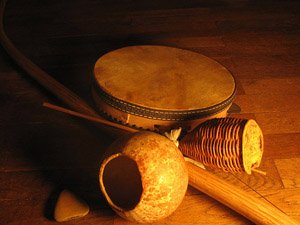|
Capoeira Instruments
It’s the instruments that really set capoeira apart from all other martial arts. This isn’t only because of their unique look and sounds. These instruments also play a huge role in the art. Without the instruments and music, there would be no capoeira. They literally set the tone. Importance of the Instruments
As covered in the history of capoeira, the instruments and music were added in an effort to disguise the fighting taking place. By adding instruments, it made it look as if the players were dancing for fun instead of training for combat. This is why the instruments became essential to capoeira. To the players it was a matter of life and death. The instruments that are used in a game tell a lot about the style of capoeira being played. In Regional style, one berimbau and two pandeiros (tambourine) are used. This is different from Angola style where three berimbaus are used at the same time. Types of Instruments
The instruments of capoeira are just as diverse and complex as the art itself. Check out more detail about each one below. Where to Buy
Virtual Capoeira is a vendor with a wide selection of instruments, from atabaques to berimbaus. Check them out here! Return from Capoeira Instruments to Start Playing Capoeira
|



 What’s the first thing that stands out to you when you see capoeira?
What’s the first thing that stands out to you when you see capoeira?